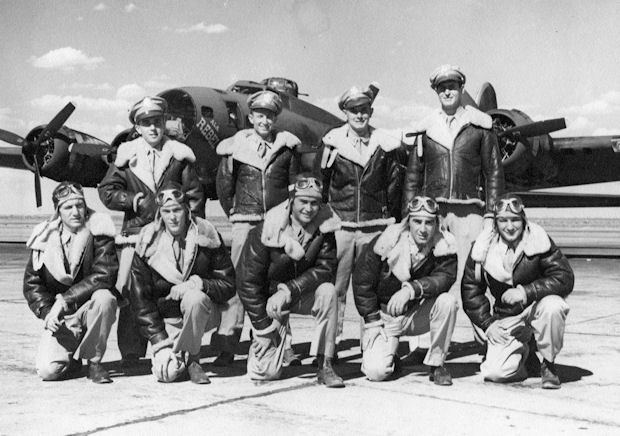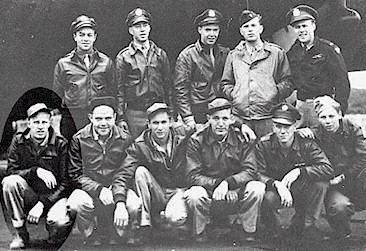Years of service 1942 - 1944 Rank Technical sergeant | Name Forrest Vosler Battles/wars World War II | |
 | ||
Born July 29, 1923Lyndonville, New York ( 1923-07-29 ) Awards Medal of Honor, Silver Star, Purple Heart, Air Medal | ||
Enlisted heritage series technical sergeant forrest l vosler
Forrest Lee Vosler, (July 29, 1923 - February 17, 1992) was a Boeing B-17 Flying Fortress radio operator who was the second enlisted (NCO) U.S. airman to ever receive a Medal of Honor. He also received the Silver Star and Air Medal.
Contents
- Enlisted heritage series technical sergeant forrest l vosler
- Biography
- Medal of Honor citation
- References

Biography

Vosler joined the United States Army Air Forces from Rochester, New York in October 1942. On a mission to Bremen, Germany, radio operator Technical Sergeant Forrest Vosler was hit twice by 20 mm shrapnel after taking the place of one of the gunners. Despite his injuries, he managed to tend to the wounded tail gunner, repair the damaged radio equipment and send off distress signals before the aircraft ditched into the sea. Vosler was awarded the Medal of Honor for his heroism during the mission. He died on February 17, 1992 and is buried at Arlington National Cemetery.

Sergeant Vosler was assigned to the 358th Bomb Squadron, 303rd Bomb Group, based at RAF Molesworth, England. At about 8:30 a.m. on December 20, 1943, Sergeant Vosler left on his fourth combat mission. His airplane, on its 28th combat flight, was a B-17F named the "Jersey Bounce Jr.," S/N 42-29664. The plane and crew reached the target area of Bremen, Germany, just before noon. The bombers encountered concentrated, accurate and intense flak over Axis territory. In addition to the anti-aircraft fire, about 125 German fighters repeatedly attacked the formation. This was a costly mission for the 8th Air Force, a total of 27 bombers were lost including the Jersey Bounce Jr. after it ditched in the North Sea. During the ditching, Vosler also saved the tail gunner's life. The badly wounded gunner (Sgt. George Buske) was removed from the still-floating ditched Fortress and put on one of the wings while the other crewmen prepared the life raft. Buske, unconscious, started to slide down the trailing edge of wing into the water. Vosler grabbed him around his waist while using his other hand to hold an antenna wire to avoid falling into the cold water. At this time Vosler had one eye badly wounded from a 20mm cannon shell that exploded right on his turret gun.
Medal of Honor citation

VOSLER, FORREST L. (Air Mission) Rank and organization: Technical Sergeant, U.S. Army Air Forces. 358th Bomber Squadron, 303d Bomber Group. Place and date. Over Bremen, Germany, December 20, 1943. Entered service at: Rochester, New York. Born: July 29, 1923, Lyndonville, New York. G.O. No.: 73, September 6, 1944.
Citation:
For conspicuous gallantry in action against the enemy above and beyond the call of duty while serving as a radio operator-air gunner on a heavy bombardment aircraft in a mission over Bremen, Germany, on 20 December 1943. After bombing the target, the aircraft in which T/Sgt. Vosler was serving was severely damaged by antiaircraft fire, forced out of formation, and immediately subjected to repeated vicious attacks by enemy fighters. Early in the engagement a 20-mm. cannon shell exploded in the radio compartment, painfully wounding T/Sgt. Vosler in the legs and thighs. At about the same time a direct hit on the tail of the ship seriously wounded the tail gunner and rendered the tail guns inoperative. Realizing the great need for firepower in protecting the vulnerable tail of the ship, T/Sgt. Vosler, with grim determination, kept up a steady stream of deadly fire. Shortly thereafter another 20-mm. enemy shell exploded, wounding T/Sgt. Vosler in the chest and about the face. Pieces of metal lodged in both eyes, impairing his vision to such an extent that he could only distinguish blurred shapes. Displaying remarkable tenacity and courage, he kept firing his guns and declined to take first-aid treatment. The radio equipment had been rendered inoperative during the battle, and when the pilot announced that he would have to ditch, although unable to see and working entirely by touch, T/Sgt. Vosler finally got the set operating and sent out distress signals despite several lapses into unconsciousness. When the ship ditched, T/Sgt. Vosler managed to get out on the wing by himself and hold the wounded tail gunner from slipping off until the other crewmembers could help them into the dinghy. T/Sgt. Vosler's actions on this occasion were an inspiration to all serving with him. The extraordinary courage, coolness, and skill he displayed in the face of great odds, when handicapped by injuries that would have incapacitated the average crewmember, were outstanding.
Taken from U.S. Air Force Biography
